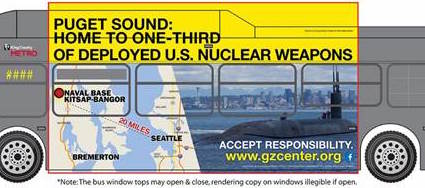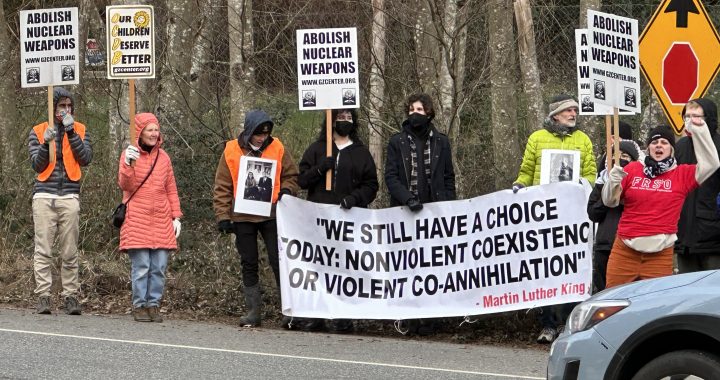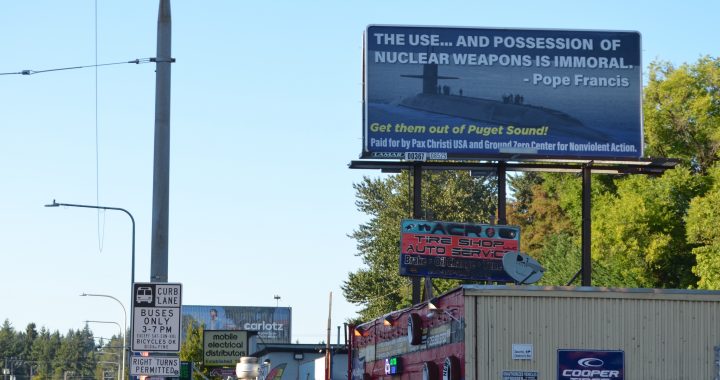On July 9, and continuing for four weeks, up to 39 Metro downtown buses will display the following paid advertisement: Puget Sound: Home to one-third of deployed U.S. nuclear weapons… Accept Responsibility. Included in the advertisement is a map showing the proximity of Seattle to Naval Base Kitsap-Bangor, home port for 8 of the Navy’s 14 Trident nuclear-powered submarines, and a U.S. Navy photo of the Trident submarine, USS Nebraska, taken on June 2, 2017 near Elliott Bay.
Also beginning on July 9, three larger versions of the ad (Ultra Super King, shown below) will appear on three Metro downtown buses for four weeks. Both ads will run an additional four bonus weeks depending upon the amount of available space on the buses.
The statement in the ad refers to the percentage of the total number of deployed U.S. strategic nuclear warheads that are deployed on Trident D-5 missiles on SSBN submarines based at Bangor.
On February 5, 2018, the date the New START Treaty entered into effect, the U.S. reported approximately 1,345 deployed strategic nuclear weapons on ballistic missiles (400 on ICBMs and 945 on SLBMs.)
The US Navy operates a fleet of 14 Ohio-class ballistic missile submarines, of which eight operate in the Pacific from their base at Naval Base Kitsap-Bangor, and six operate in the Atlantic from their base at Naval Submarine Base Kings Bay, in Georgia. This distribution accounts for approximately 540 deployed strategic warheads on six operational submarines at Bangor.
Hans M. Kristensen is the expert source for the statement, “Puget Sound: Home to one-third of deployed U.S. nuclear weapons.” (See cited source material here and here.) Mr. Kristensen is director of the Nuclear Information Project at the Federation of American Scientists where he provides the public with analysis and background information about the status of nuclear forces and the role of nuclear weapons.
The bus ads are an effort by Ground Zero Center for Nonviolent Action, a grass roots organization in Poulsbo, Washington, to reawaken public awareness of the dangers of nuclear weapons in the Puget Sound region.
Civic responsibility and nuclear weapons
Our proximity to the largest number of deployed strategic nuclear weapons puts us near a dangerous local and international threat. When citizens become aware of their role in the prospect of nuclear war, or the risk of a nuclear accident, the issue is no longer an abstraction. Our proximity to Bangor demands a deeper response.
Citizens in a democracy also have responsibilities–which includes choosing our leaders and staying informed about what our government is doing. The submarine base at Bangor is 20 miles from downtown Seattle, yet only a small percentage of citizens in our region know that Naval Base Kitsap-Bangor exists.
Citizens of Washington State consistently elect governmental officials who support nuclear weapons in Washington State. In the 1970s, Senator Henry Jackson convinced the Pentagon to locate the Trident submarine base on the Hood Canal, while Senator Warren Magnuson obtained funding for roads and other impacts caused by the Trident base. The only Trident submarine to be named after a person (and our Washington State Senator) is the USS Henry M. Jackson (SSBN-730), homeported at Naval Base Kitsap-Bangor.
In 2012, Washington State established the Washington Military Alliance (WMA), strongly promoted by both Governor’s Gregoire and Inslee. The WMA, Department of Defense, and other governmental agencies work to strengthen the role of Washington State as a “…Power Projection Platform (Strategic Ports, Rail, Roads, and Airports) [with] the complementary air, land, and sea units with which to accomplish the mission.” Also see “power projection.”
Naval Base Kitsap-Bangor and the Trident submarine system has evolved since the first Trident submarine arrived in August 1982. The base has upgraded to a much larger D-5 missile with a larger W88 (455 kiloton) warhead, with ongoing modernization of missile guidance and control systems. The Navy is currently planning to implement a smaller W76-2 “low-yield” or tactical nuclear weapon (approximately 6.5 kilotons) on ballistic submarine missiles at Bangor, dangerously creating a lower threshold for the use of nuclear weapons.
The issues
* The U.S. is spending more on nuclear weapons programs than during the height of the Cold War.
* The U.S. currently plans to spend an estimated $1.7 trillion over 30 years for rebuilding the nation’s nuclear facilities and modernizing nuclear weapons.
* The New York Times reported that the U. S., Russia and China are aggressively pursuing a new generation of smaller and less destructive nuclear weapons. The buildups threaten to revive a Cold War-era arms race and unsettle the balance of power among nations.
* The U.S. Navy states that SSBN submarines on patrol provide the U.S. with its “most survivable and enduring nuclear strike capability.” However, SSBNs in port and nuclear warheads stored at SWFPAC are likely a first target in a nuclear war. The latest Google imagery shows three SSBN submarines on the Hood Canal waterfront.
* An accident involving nuclear weapons occurred on November 2003 when a ladder penetrated a nuclear nosecone during a routine missile offloading at the Explosives Handling Wharf at Bangor. All missile-handling operations at SWFPAC were stopped for nine weeks until Bangor could be recertified for handling nuclear weapons. Three top commanders were fired, but the public was never informed until information was leaked to the media in March 2004.
* Public responses from governmental officials to the 2003 missile accident were generally in the form of surprise and disappointment.
* Due to ongoing modernization and maintenance programs for warheads at Bangor, nuclear warheads are routinely shipped in unmarked trucks between the Department of Energy Pantex Plant near Amarillo, Texas and the Bangor base. Unlike the Navy at Bangor, the DOE actively promotes emergency preparedness.
The bus ad
The 39 bus ads (the actual number will depend upon the amount of available space on the buses) begin on July 9 and measure 30 inches tall by 144 inches in length and are posted on the sides of Metro buses in downtown Seattle. The three “Ultra Super King” ads, that also begin on July 9, wrap from wheel to wheel on the side of the bus and from top to bottom of the bus. Ground Zero Center for Nonviolent Action purchased four weeks of both bus ads. King County Metro will run the ads for an additional four bonus weeks as space is available. The smaller ads are expected to run for at least eight weeks or longer.
The photo of the submarine in the ad is from a U.S. Navy DVIDS website, at https://www.dvidshub.net/image/3446233/uss-nebraska-ssbn-739-departs-psns-imf-sea-trials. The caption for the photo states:
170602-N-TA321-501 PUGET SOUND, Wash. (June 02, 2017) The Ohio-class ballistic-missile submarine USS Nebraska (SSBN 739) passes by Seattle during sea trials after completing an extended major maintenance period, to include an engineered refueling overhaul at Puget Sound Naval Shipyard and Intermediate Maintenance Facility. (U.S. Navy photo by Culinary Specialist Seaman Joseph W. Weiser/Released)
Nuclear weapons and resistance
In the 1970s and 1980s, thousands demonstrated against nuclear weapons at the Bangor base and hundreds were arrested. Seattle Archbishop Hunthausen had proclaimed the Bangor submarine base the “Auschwitz of Puget Sound” and in 1982 began to withhold half of his federal taxes in protest of “our nation’s continuing involvement in the race for nuclear arms supremacy.”
One Trident SSBN submarine at Bangor is estimated to carry about 90 nuclear warheads. The W76 and W88 warheads at Bangor are equal respectively to 100 kilotons and 455 kilotons of TNT in destructive force. One submarine deployed at Bangor is equal to more than 1,000 Hiroshima-sized nuclear bombs.
On May 27, 2016, President Obama spoke in Hiroshima and called for an end to nuclear weapons. He said that the nuclear powers “…must have the courage to escape the logic of fear, and pursue a world without them.” Obama added, “We must change our mindset about war itself.”
_______________________________________________
The Ground Zero Center for Nonviolent Action was founded in 1977. The center is on 3.8 acres adjoining the Trident submarine base at Bangor, Washington. The Ground Zero Center for Nonviolent Action offers the opportunity to explore the roots of violence and injustice in our world and to experience the transforming power of love through nonviolent direct action. We resist all nuclear weapons, especially the Trident ballistic missile system.
Upcoming Ground Zero-related events (check our Events calendar for more information):
* The annual Interfaith Peace Walk led by Bainbridge Island Nipponzan Myohoji Buddhist Temple takes place from July 25 to August 6. See http://nipponzan.org/wordpress
* Ground Zero Peace Fleet! in Elliott Bay on July 31.
* From Hiroshima to Hope event at Green Lake on August 6 commemorating the victims of the Hiroshima bombing 71 years ago. See http://fromhiroshimatohope.org
* Boats by Bangor on August 4, a flotilla of kayaks and small boats in the waters of Hood Canal out past the perimeter of Naval Base Kitsap Bangor.
* The Annual Ground Zero Hiroshima/Nagasaki Commemoration on August 4 through 6 at Ground Zero Center for Nonviolent Action with a vigil and nonviolent civil resistance at entrance to Bangor.







